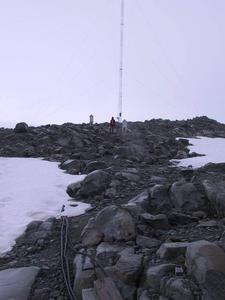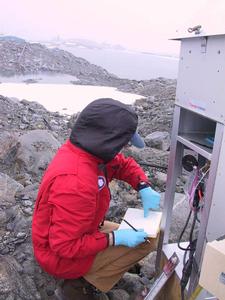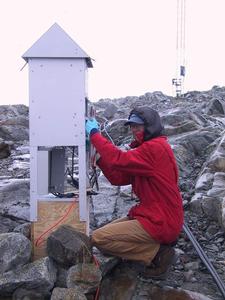4 February, 2002
FILTERING THE AIR FOR POPS
The POPs team is filtering the air to measure for any
persistent organic pollutants (POPs) that might be here. Other scientists
have found POPs in the Antarctic food web: in fish, Minke whales, penguins,
and other birds. So it is well known that POPs may be here.
This team is looking for POPs in the air and water. We are looking at ways
that POPs might enter the food web. We take air samples from two devices or
stations set up in the "backyard". This is at the back of Palmer Station.
To get there we climb up and over a lot of the rock that makes up this
island. Rebecca Dickhut chose this location because it is downwind from the
glacier. It is also close enough to the station for electrical power that
is needed to collect the air samples.
Each air sampling device has a paper filter and a canister that holds two
"PUFs", or foam plugs. The paper filter is 8 inches by 10 inches. The
paper and the foam plugs will collect any aerosol parcticles of POPs that are
in the air. The air coming off the glacier is forced through the filters by
a generator-powered pump. One device can draw 1200 cubic meters of air
through it in a 24 hour period, and the other device can draw 1000 cubic
meters of air in a 24 hour period.
Rebecca has been changing the filters and plugs are various times.
Sometimes we have changed them every 36 hours, and sometimes we have changed
them every 24 hours. We are taking short and long time samples during each
week. The paper filters and the foam plugs will be taken back to the
Virginia Institute of Marine Science for analysis.

These jars hold the PUFs--foam plugs. The plugs were cleaned very carefully in Virginia before they were brought down here. They are ready to be put into the air filtering devices.

Rebecca uses a clean air glove box within which she transfers new plugs to the filtering devices that we'll take outside.

This area is the "backyard" of Palmer Station. It is between the buildings and the glacier.

This is typical weather at Palmer Station this summer. It has rained and snowed when we have changed filters. Sometimes it is quite windy.

This is a close up view of one of two devices.

Rebecca Dickhut fits the filter together. The bottom canister holds two PUF plugs, and the flat top holds the paper filter.

The filter (and another one just like it) are ready to be taken out to the site where they are used.

Rebecca Dickhut records information from the air filtering device.

Rebecca at one of the two air filtering stations.
Contact the TEA in the field at
.
If you cannot connect through your browser, copy the
TEA's e-mail address in the "To:" line of
your favorite e-mail package.
|
